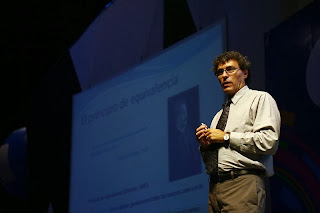Miguel Alcubierre Moya (born 1964, Mexico City) is a Mexican theoretical physicist.[1] He obtained a degree in physics, and a Master of Science in theoretical physics at the School of Science of Universidad Nacional Autónoma de México (UNAM).
At the end of 1990, Alcubierre moved to Wales to attend graduate school at the University of Wales, Cardiff, receiving his doctorate through study of numerical general relativity.[1][2][3] After 1996 he worked at the Max Planck Institute for Gravitational Physics in Potsdam, Germany, developing new numerical techniques used in the description of black holes. Since 2002, he has worked at the Nuclear Sciences Institute of the National Autonomous University of Mexico (UNAM), where he conducts research in numerical relativity, employing computers to formulate and solve the physical equations first proposed by Albert Einstein.[4] The solitary wave solutions proposed by Alcubierre for the Einsteinian field equations may possibly prove general relativity consistent with the experimentally verified non-locality of quantum mechanics. This work militates against the idea that quantum non-locality would ultimately require abandoning the mathematical structure of general relativity.
On 11 June 2012, Miguel Alcubierre was appointed Director of the Nuclear Sciences Institute at the National Autonomous University of Mexico (UNAM).
Alcubierre is best known for the proposal of "The Warp Drive: Hyper-fast travel within general relativity" which appeared in the science journal Classical and Quantum Gravity.[5] In this, he describes the Alcubierre drive, a theoretical means of traveling faster than light that does not violate the physical principle that nothing can locally travel faster than light. In this paper, he constructed a model that might transport a volume of flat space inside a "bubble" of curved space. This bubble, named as Hyper-relativistic local-dynamic space, is driven forward by a local expansion of space-time behind it, and an opposite contraction in front of it, so that theoretically a spaceship would be placed in motion by forces generated in the change made by space-time.
WikipediaAbstract
It is shown how, within the framework of general relativity and without the introduction of wormholes, it is possible to modify a spacetime in a way that allows a spaceship to travel with an arbitrarily large speed. By a purely local expansion of spacetime behind the spaceship and an opposite contraction in front of it, motion faster than the speed of light as seen by observers outside the disturbed region is possible. The resulting distortion is reminiscent of the "warp drive" of science fiction. However, just as it happens with wormholes, exotic matter will be needed in order to generate a distortion of spacetime like the one discussed here.
Physics arXiv: The warp drive: hyper-fast travel within general relativity
Miguel Alcubierre, Department of Physics and Astronomy
University of Wales, College of Cardiff, UK
Amazing Mexicans: Miguel Alcubierre Moya, PhD
#P4TC links:
Alcubierre Drive
As Dreams Are Made Of
Warp Fields and Research Efficacy
I'm Given Her All She's Got, Captain

Comments